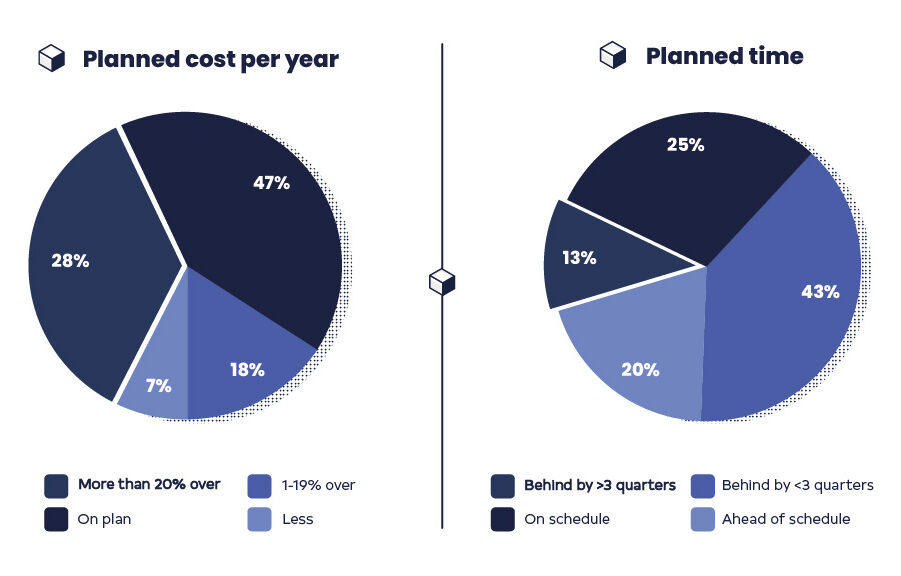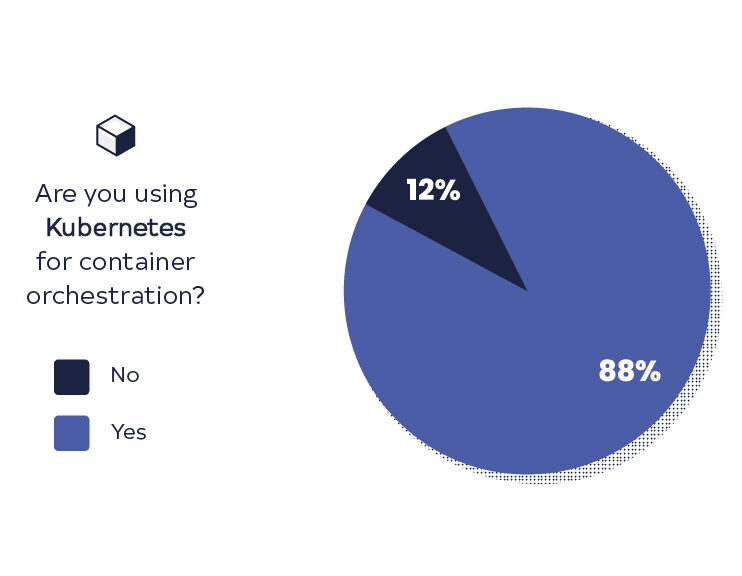
Cut costs and delays in cloud migration by (1) marrying your business case with the right technology, and (2) partnering with a consultant that will have your back when things go south.
Read on for a run-down of several battle-tested cloud solutions paired with suitable business examples.
In this article:
- Why even 30% of cloud migrations miss their targets
- Two reasons behind cloud migrations success
- Why you should opt for Kubernetes
- Why choosing the right distribution matters
- Four distributions to consider
- Why only four? The reason behind our trimmed-down menu.
- Vanilla Kubernetes
- RedHat OpenShift
- Tanzu
- Mirantis
- Why you should hire a cloud migration consultant
Why even 30% of cloud migrations miss their targets
According to the McKinsey Institute, more than one in ten companies implementing cloud migration misses the deadline by over three quarters, while nearly one in three goes over the budget by at least 20% (Fig. 1)

Fig. 1: Cloud migration cost overruns. Source: McKinsey Institute.
McKinsey identifies two principal reasons for this. Poor process management, including the failure to choose the right cloud solution, inflates the cost by 14%.
Another factor is a lack of in-house cloud experts. On average, companies wishing to move to the cloud have 40% fewer specialists on board than needed to successfully go through with the transition.
Two reasons behind cloud migrations success
Considering the data, a successful cloud migration requires:
1. taking great care in recognizing the right cloud solution,
2. offsetting the likely shortage of cloud talent by outsourcing it.
Sometimes (1) needs outsourcing, too.
Why you should go with Kubernetes as your cloud migration solution
Although Kubernetes is not the only cloud solution available on the market, it is the accepted industry standard, powering 88% of enterprise containerized architectures (Fig. 2).
In reality, though, this information doesn’t tell you much. Kubernetes is an engine. It won’t get you far without a frame – whether built by yourself or provided by someone else.

Fig. 2: Kubernetes enterprise adoption, source: RedHat
Choosing the right distribution matters
Commercial vendors take Kubernetes – the “engine” – and augment it. The engine becomes a vehicle: a distribution. If your business hopes to move ahead, it will do so more quickly in a full-fledged car than with a bare-bones engine on its back.
The “only” problem is choice. Because Kubernetes is open-source, its offshoots can theoretically run into thousands. Indeed, the official Kubernetes website lists sixty-eight certified Kubernetes platforms. How to make sense of this abundance?
That’s where the decision-making part kicks in. Navigating the many distributions and their often subtle differences proves challenging, and making the wrong call can cost your business real money.
Why does it matter which Kubernetes distribution you’ll pick? For one thing, depending on the business context, you may either pay nothing at all or pay through the nose – that’s how big a price range the various distributions cover.
What you’ll find next
- First, we’ll give you an overview of all the Kubernetes distributions we’ve worked with. You’ll see the pros and cons, what business cases they match best, and what risks their use might entail.
- Then, we’ll briefly show when and why we used each distribution – with real-life examples to illustrate the considerations that go into choosing the best option.
Four Kubernetes distributions to consider
Why only four? Since Kubernetes spawned nearly seventy officially supported distributions, you might be wondering why we’ve trimmed the number down to a meager four.
Firstly, the list represents what we consider the strongest options. And secondly, we’d much rather talk about the things we know than regurgitate content from elsewhere. What follows is a proven overview of each platform backed by our hands-on experience.
Vanilla Kubernetes: when you’re small, on a budget, and willing to make an extra effort

The pros: It doesn’t cost anything apart from the electricity to download it. You can go to the Kubernetes website right now and get everything for your container orchestration needs, free of charge.
The cons: Vanilla Kubernetes will keep your costs down if you compensate for everything else with skill and effort. That includes installation, configuration, maintenance, etc. Instead of money, you’ll be investing time.
Perfect for: Small projects with limited funds and flexible schedule.
Potential downsides: It saves money but may prolong the migration.
Where did we use it and why?
In our project for a postal company, we used Kubernetes On-Premises because the client’s priority was to minimize costs. In addition, their Kubernetes cluster was relatively small, consisting of no more than 10 virtual machines – so the circumstances called for Vanilla Kubernetes.
RedHat OpenShift: when you’re big and seek an all-in-one solution

The pros: You get the most comprehensive cloud solution on the market. Nothing else compares. The process of installation, upgrading, maintenance, and scaling is simply a breeze.
The cons: It will strain your budget: the most feature-rich and no-hassle distribution also comes at a price – one of the highest ones out there.
Perfect for: Large enterprises and huge corporations, especially if they use other RedHat products or services.
Potential downsides: The cost
Where did we use it and why?
Because cost wasn’t an issue, we recommended OpenShift to one of the largest money transfer companies in the world. They had already been using other RedHat services, so compatibility factors also played a part in the decision.
Tanzu: for VMWare users

Tanzu is a Kubernetes distribution curated and delivered by VMWare with a special focus on VMWare infrastructure.
The pros: Works great if you’re already running VMWare software, it’s also less pricey than OpenShift.
The cons: Requires VMWare’s vSphere installed for optimal use, plus it isn’t as feature-packed as OpenShift.
Perfect for: Large enterprises with VMWare systems in place plus considerable budgets.
Where did we use it and why?
Tanzu was a great fit for a postal service we worked with, because they were already using VMWare technology.
Mirantis: you need more control, security, and can afford hardware

Although absent from most Kubernetes distribution round-ups, Mirantis still runs on Google’s container orchestration engine, but is meant for on-premises installations.
The pros: Because it runs on site, Mirantis provides more control and security.
The cons: Only suitable for on-premises installations, which means you need to factor in the purchase of infrastructure.
Perfect for: Companies focused on control and security – often the financial sector.
Where did we use it and why?
Because it runs on-premises, Mirantis fit the bill for one of the largest banks in Scandinavia that enlisted our services. Being a financial institution, they understandably opted for a cloud implementation on-site.
Additionally, the bank’s use of Jenkins, an open-source automation server, made integration with Mirantis easier.
Why you should hire a cloud migration expert?
This short overview of several Kubernetes distributions and their real-life enterprise applications should give you some pointers on finding the right cloud solution for your business case.
It’s worth remembering, however, that everything depends on the context. No article can account for all potential scenarios, so if you’re in doubt, reach out to a technology consultant. They will not only assist you in making the best possible decision but also walk you through the entire implementation process from start to finish.
The truth is that the journey to cloud migration is fraught with the unexpected. Even if consultants seem superfluous for 90% of the time, they exist precisely for the remaining 10% – when something blows up and they step in to pick up the pieces.
Contact us and we will have you covered in 100%.